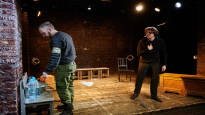PETER Even though the war in Ukraine has frozen relations between Russia and Finland, a group of Finnish language and theater people in St. Petersburg wants to keep the Finnish-speaking culture of the big city alive.
The new Finnish-language theater project established in the city is led by a respected Finnish language teacher and linguist Olga Milovidovadirector Seppo Kantervo and producer Pavel Smirnov.
In January, the Finnish theater in St. Petersburg was launched by a Hungarian Miklós Hubayn (1918–2011) work Silence. The play has been performed in the Osobnjak Theater in St. Petersburg.
The play was originally premiered in Petrozavodsk as the final work of acting students at the conservatory in the spring of 2021.
The play, written by Hubay in the 1970s, takes place in an unnamed country, and tells about the last day of the last speaker of a disappearing language.
– Silence is a story about language, how language disappears and under what conditions it happens, says director Seppo Kantervo.
The main role is played by an actor Ronja Kinnunen, who works at the National Theater in Petrozavodsk. The second person in the play, Igor Turnovsky the priest played would like to learn a dying language.
– It opens up the tragedy of what it means objectively when something truly human like a nation’s language and culture is simply erased, Ronja Kinnunen describes.
The play is performed in two languages, Finnish and Russian, partly translated into Russian.
In the tragedy of the play, you can feel the hum of war, and this theme has suddenly become very topical.
– When we started presenting this at the very beginning, there were quite a lot of comments about that war theme, Ronja Kinnunen says. He feels that the play comments on the war and, as a tragedy, is clearly anti-war.
– After every performance, people have come to thank me for the play, Ronja Kinnunen says about the reception in Petroskoi.
The themes of the play seemed to resonate in St. Petersburg as well.
– In the discussion after the play, there was a need to discuss such issues.
The archival discovery inspired me
The project to establish a Finnish-language theater in St. Petersburg got a boost when the long-time Finnish language teacher and philologist Olga Milovidova came across an archival discovery in St. Petersburg’s state theater library.
It was about plays in Finnish that were sent to the censorship authorities of Imperial Russia for review. There are 400 plays in the collection.
– It is a large collection, the fourth largest in terms of national minority languages. After Ukraine, Latvia and Estonia, the Finnish language is in fourth place, says Milovidova.
One inspiration was the University of Tampere Tiina Syrjän conducted theater art courses. The students made plays in a language that the students themselves do not know.
In 2019, Olga Milovidova saw a play performed in Russian by Finnish students. He was interested in how it was possible.
– Theatrical art, the actor’s professionalism, requires penetration into the character’s fate and story, not only on a linguistic level but much deeper, Milovidova explains.
Finnish theater also runs language laboratories for both actors and children.
There was a Finnish theater in Leningrad
The project has also been inspired by the example of the Finnish-language theater in Leningrad. A historian in Russia Tamara Smirnova has studied history of national theaters (you switch to another service).
The fate of the Leningrad theater was sad. In the peak year of Stalin’s terror in 1937, it fell into the teeth of the security apparatus.
National theaters were accused of being “nests of bourgeois nationalism”. Most of the actors of the Leningrad theater were imprisoned and shot in the persecutions.
Director Seppo Kantervo, who started his career at Petroskoi National Theater, also knows the background of the theater.
Two actors who survived the persecutions from the Finnish theater in Leningrad worked there at one time: Walter Sunwho later became a director, and Liisa Tombergwho later received the title of People’s Artist of the Soviet Union.
The theater is part of St. Petersburg’s multinational culture
Olga Milovidova says that the Finnish-language theater represents St. Petersburg’s multinational cultural heritage.
– It is Peter’s answer to modern times.
According to him, the idea that all flags are welcome has always been characteristic of Pietar.
That’s why he thinks it’s important that in St. Petersburg you can watch and hear theater in Finnish.
Due to Russia’s war in Ukraine, Finland has severed official cultural relations with Russia, and visa restrictions reduce interaction.
The Finnish theater in St. Petersburg wants to maintain spiritual connections across borders.
– We are on the border, in the border area. It is the kind of area where people are inextricably linked. You can’t build a wall. We have a lot of family relationships, historical relationships, says Seppo Kantervo.
– It can be destroyed, but it will take several thousand years.
The Finnish theater people call their project a bridge.
A bridge can be built in consciousness, and such bridges can be stronger than real bridges, says Olga Milovidova.
– The stone bridge can be destroyed, but no one can destroy this bridge.
New plans are already in the works. At the beginning of June, there will be a premiere in St. Petersburg’s Theater Museum Yrjö Heilalan A meeting of bun spinners from 1905.
– We are not even planning when the Finnish theater in St. Petersburg will be able to visit Finland, but we can dream about it, Olga Milovidova says.
